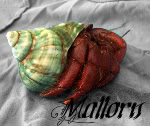The purpose of this is to demonstrate how to achieve "professional" quality results in an affordable 10g setup.

Basic ingredients shown:
$10.00 - 10g glass tank
$ 3.00 - A bag of playsand
$ 3.00 - Two hamster bowls (check thrift stores for cheaper)
$ 3.00 - Food dish (thrift too)
$ 7.00 - Plastic cave shelter
$ 3.00 - Fake plants (walmart is cheapest)
$ 4.00 - Four sponges (craft stores are cheapest)
The tank is filled with sand twice as deep as your largest crab.
The hamster dishes are good because they are deep so they hold more water and run out slower, and are heavier so they resist toppling by small and medium sized crabs. Be aware that sand bridges into the bowls will still wick the water out. Because they are deep, sponges are used so that tiny crabs don't drown. Also, the sponges prevent easy submerging. You want to prevent weak or PPS crabs from submerging until they are healthier. One dish is for fresh, the other salt. Do not place them in corners, because crabs tend to dig into corners, which will result in more toppled water dishes.
Some kind of shelter is needed for the crabs, and the foilage does the rest of the job of creating a "safe, secure" crabitat for the crabs. They will feel more secure being out on the surface with more hiding spots. You can save 10$ by making your own shelter or food dish out of household items.
If you don't have large/jumbo crabs, a cholla to climb up higher on is also recommended. With large crabs though, they can get too close to the top where they could escape, especially since the sand will need to be much deeper then. I do not recommend having large or jumbo crabs in a 10g at all if being used as a main tank. Only place them there for ISOing, in which case it doesn't matter if they can't climb for a few weeks.
Sand is cleaner than compressed cocofiber, so the water won't stay disgusting all the time. I replenish the water regularly, and clean the bowls and swap sponges once a week. Keep the sand around the bowls moist, so that you can take them out for cleaning and put them back in the same spot, and the sand-walls will remain intact.

Environmental control ingredients shown:
$10.00 - Under tank heater (UTH)
$ 0.00 - DIY wooden stand to keep the airflow under the tank
$10.00 - Glass lid, with broken chopstick for "propping"
$ 3.00 - Incandescent fixture (gotta go thrift store here)
$ 6.00 - 25w moon-glow bulb
$12.00 - Humidity and temperature gauge
-10.00 - Account for not really needing both UTH and lights
Humidity is maintained not by sponges or misting, but by my corner-hole method.

Finger a hole into each corner, and dump 1/4 cup dechlor water into each hole. The water will seep into the lower-substrate and provide consistent humidity for a couple weeks at a time.
Regulate the humidity on a fine degree by increasing or decreasing the amount the lid is propped open. Keeping it more-propped will have lower humidity and lower temp with better airflow, and keeping it less-propped will have higher humidity and higher temp with less airflow. You can save 10$ by using seran wrap, plexiglass, or some other non-porous cover instead of a glass hinged lid.
Adding a bubbler or DIY humidifier will help maintain airflow while keeping humidity high.
Temperature is maintained either with a UTH or lights. A UTH is sufficient for the 10g, and much cheaper, unless you can find a light fixture used somewhere.
Final ingredients:
$ 3.00 - Water conditioner
$10.00 - Sea salt
$ 5.00 - Preservative-free food
$ 1.00 - Two gallon water jugs
$ 5.00 - Shells
Whatever brands you want. The water conditioner must remove chlorine and chloramines and heavy metals. Crab Island food is a commercial food that's free of the worst preservatives. There are several members that vend homemade natural foods as well.
Don't forget extra shells for your hermits. Check thrift stores and garage sales, and craft stores. There's also some good websites.
Total cost: ~$85
And in the end, you have this:

The upfront cost is real. These aren't throwaway pets. And considering that many "kits" or "starter sets" from kiosks will run 30-50$, for around the same price you can do it right.
In the long run, maintenance costs are low. The only items you need to replenish are:
Food every few months
and
Water conditioner, sand, sea salt, new fake plants every year or so.
The rest will last forever, and much of it can even be used if you upgrade to a larger tank.
And the bonus question: Can anyone guess what's wrong with my ISO?






